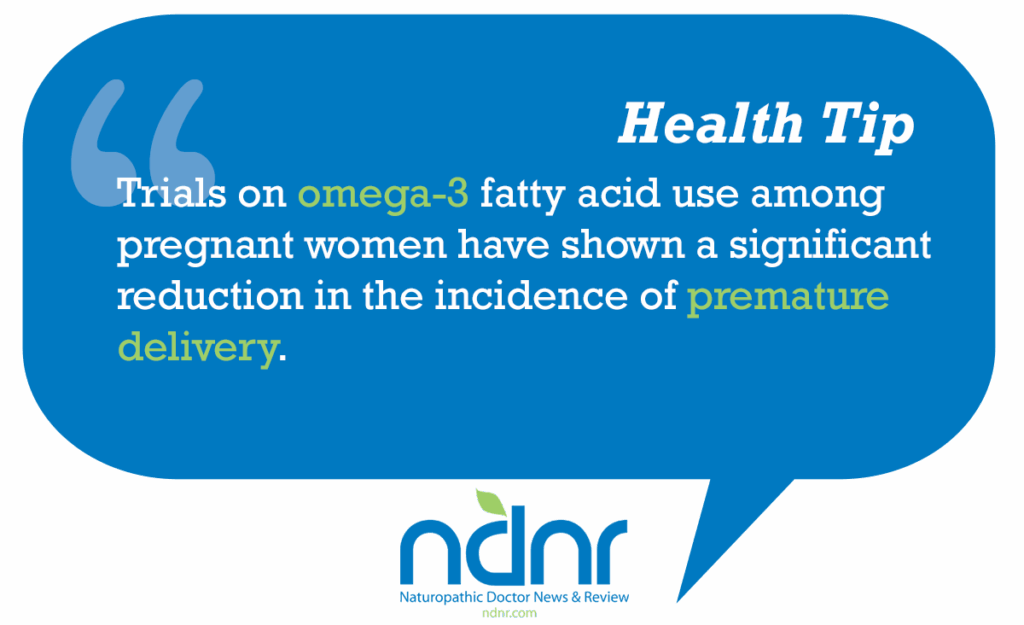Omega-3s: Condition-Specific and Function-Specific Uses in Women’s Health
Tori Hudson, ND
It is estimated that approximately 80% of Americans consume a diet deficient in essential fatty acids (EFAs).1 The balance of fats in the typical North American diet is dramatically out of sync with the needs of our bodies. An insufficiency of fish and fish oils in our diet has led to a decrease in our intake of omega-3 fatty acids by about 80% during the past century. Deficiencies of EFAs, which are so vital to many of the body’s most basic functions, can lead to many health problems for men and women.
When using omega-3 fatty acids from fish oils, it assists the clinician greatly to not only be familiar with the research but also to know the amounts of eicosapentaenoic acid (EPA) and docosahexaenoic acid (DHA) to achieve optimal clinical results. A summary and review of the research in select areas of reproductive and primary healthcare for women will assist the practicing clinician in more specific uses of EPA-DHA from fish oils in the following areas of women’s health: menstrual cramps, osteoporosis, menopause, and pregnancy and fetal development.
Menstrual Cramps
Foods that are high in arachidonic acid (such as meat) may be a contributing factor to menstrual cramps. The body uses arachidonic acid to produce the potentially harmful prostaglandin-E2. This prostaglandin causes the muscle and uterine contractions of cramping. The best medicinal foods and oil supplements to relieve menstrual cramps are those that increase the antispasmodic prostaglandin-E1 and prostaglandin-E3. Fish such as salmon, tuna, halibut, sardines, mackerel, and herring contain EPA, which helps to relax muscles by stimulating the production of these prostaglandins. In a study2 of fish oil, adolescent girls with menstrual cramps were given a fish oil supplement containing EPA (1080 mg) with DHA (720 mg) for 2 months. As many as 73% of the patients rated the fish oil supplement as being moderately or totally effective in relieving their menstrual cramps.
Osteoporosis
Although EFAs have not been talked about much in regard to osteoporosis, it seems evident from the available research that we must expand our use of EFAs to maximize calcium metabolism and to preserve bone health. A growing body of evidence and research warrants advice about EFAs and calcium metabolism, bone health, and the prevention of osteoporosis. Essential fatty acids have been shown to ameliorate calcium absorption from the gut (in part by enhancing the effects of vitamin D), reduce urinary excretion of calcium, increase calcium that is deposited in the bone, and improve the strength of bone.3 Adults with osteoporosis who are given fish oil show an increase in calcium levels and greater urinary calcium clearance.4 Gamma-linolenic acid in particular has been shown to reduce the excretion of calcium5 and inhibit bone reabsorption and markers of bone turnover, while at the same time increasing the levels of calcium content in the bone.6 Using different ratios of evening primrose oil (high in gamma-linolenic acid), fish oil (rich in EPA and DHA), sunflower oil, and flaxseed oil, the results of animal investigations suggest that supplementation with high quantities of evening primrose oil and fish oil is more effective in inhibiting bone loss than linoleic acid and alpha-linolenic acid.7
Menopause
Two studies have demonstrated that fish oils can reduce the frequency of hot flashes. In the first study,8 women were between 40 and 55 years old and had moderate to severe psychological distress, defined as a score of 72 or higher on the Psychological General Well-being Schedule. Only women with hot flashes were included in the analysis. One hundred twenty women were randomly assigned to ethyl-EPA (E-EPA) omega-3 fatty acid supplementation or to placebo for 8 weeks. The E-EPA supplementation was a 500-mg capsule taken 3 times per day, with each capsule containing EPA (350 mg) and DHA (50 mg). After 8 weeks, the hot flash frequency decreased in the E-EPA group by a mean of 1.58 per day and by only 0.50 per day in the placebo group. There was a significant 55% reduction in the hot flash frequency among the E-EPA group compared with only a 25% decrease in the placebo group. Also, the responder rate was 58.5% in the E-EPA group compared with 34.4% in the placebo group. However, no differences were observed in hot flash severity or in the quality-of-life scores between the 2 groups.
In the second study,9 perimenopausal or postmenopausal women received 2 g/d of fish oil (each gram contained 840 mg of EPA and 375 mg of DHA). This study had the primary objective of evaluating the use of omega-3 fatty acids to treat depressive symptoms among perimenopausal and postmenopausal women with major depressive disorder. The secondary outcome was a change in hot flashes. Using the Montgomery-Asberg Depression Rating Scale, the response (a ≥50% decreased score on the scale) rate to omega-3s was 70%, and the depression remission rate was 45%. Among those women with hot flashes at baseline, the number of hot flashes each day improved significantly, as did the scores on the Hot Flash Related Daily Interference Scale. It was observed that the responders had significantly lower serum DHA levels before treatment compared with the nonresponders.
Pregnancy and Fetal Development
Essential fatty acids have a unique role during pregnancy because of the rapid development of new cell growth, new tissues, and new organ systems in a developing fetus. Fetal development is associated with a high EFA requirement, and this supply is depe ndent on the amount and availability of EFAs from the mother.
ndent on the amount and availability of EFAs from the mother.
Maternal levels of omega-3 fatty acids, especially DHA, decrease during pregnancy.10 Essential fatty acids are components of breast milk, and maternal levels may be reduced further in women who are nursing. For the fetus, a deficiency in EFAs, particularly EPA and DHA, may lead to a poorly developed central nervous system. An EFA deficiency may be a risk factor for preterm birth and may lead to intrauterine growth retardation (IUGR), resulting in a lower whole body weight and in slower growth of the brain.
Trials on omega-3 fatty acid use among pregnant women have shown a significant reduction in the incidence of premature delivery.11 More than 20 years ago, Olsen et al12 suggested that dietary fats and the type of fats in the diet may influence gestational duration. In islands off the coast of Denmark, women were delivering their infants after 40 weeks of gestation, but a high percentage of women in other parts of Denmark would go into labor about 1 week earlier. The researchers hypothesized that a marine diet with a high intake of omega-3 fatty acids from fish might be responsible for prolonging pregnancy by shifting the prostaglandin balance. In a subsequent clinical trial,13 the same research group investigated a fish oil supplement for its effects on pregnancy duration, birth weight, and birth length. Five hundred thirty-three healthy Danish women were randomized to receive a daily regimen of four 1-g fish oil capsules (containing 2.7 g/d of omega-3 fatty acids), four 1-g olive oil capsules, or no supplementation. The fish oil-supplemented pregnancies lasted 4 days longer than the olive oil-supplemented pregnancies. The pregnancy duration was shortest in the olive oil group, and the birth weight was 107 g greater in the fish oil group compared with the olive oil group. The authors concluded that fish oil supplementation in the third trimester seemed to prolong pregnancy, without any detrimental effects on the growth of the fetus or on the course of the labor.
In the Fish Oil Trials in Pregnancy study, Olsen et al14 investigated the effects of dietary omega-3 fatty acids on preterm delivery, as well as several other pregnancy outcomes. A total of 232 women with a history of preterm delivery were randomized to 2.7 g/d of fish oil supplement or to olive oil placebo from week 20 of their pregnancy until delivery. The fish oil supplement reduced the risk for preterm delivery from 33.3% to 21.3%.
In another study,15 infants born to mothers who had been given cod liver oil had higher levels of DHA in their umbilical cord and a longer gestation. In a study16 of pregnant women in Iceland, those consuming liquid cod liver oil in the first 15 weeks of pregnancy had infants with higher birth weight.
Prostaglandins are involved in the development and clinical expression of preeclampsia. The prostaglandins are modulators of vascular smooth muscle tone and platelet aggregation. In preeclampsia, there is a disturbance in the biosynthesis of thromboxane and prostacyclin. Fish oil supplementation was studied in late pregnancy to determine whether it influenced production of the omega-6–derived thromboxane A2 and prostacyclin 12 in the mother and the fetus.17 Forty-seven women in their 13th week of pregnancy were randomly assigned to a fish oil supplement, olive oil, or no supplementation. The mean concentrations of the EPA-derived metabolites thromboxane B3 and prostacyclin 13 were 2 to 3 times higher at week 37 in the fish oil group compared with the olive oil group and the group receiving no supplementation. The fish oil did not affect the prostacyclin 12 metabolite. In the umbilical cord blood, the mean concentration of thromboxane B21 was significantly lower in the fish oil group compared with the olive oil group and the no supplementation group. This metabolism of fish oil to thromboxane A3 and prostacyclin 13 in pregnant women is the basis for theorizing that fish oil may help prevent pregnancy-induced hypertension (PIH) or IUGR.
However, supplementation trials of fish oil have not reduced the risk for PIH or IUGR. In a double-blind trial,18 more than 200 women who were at high risk for PIH or IUGR were randomized to receive 2.7 g/d of fish oil (containing 1.62 g of EPA and 1.08 g of DHA) or to placebo. No difference was observed between the fish oil group and the placebo group and in PIH, birth weight, or gestational duration.
While the Fish Oil Trials in Pregnancy study14 demonstrated a reduced risk for preterm delivery with fish oil supplementation, an earlier study13 showed that fish oil had no effect on preterm delivery of twins and no influence on PIH or IUGR. In that analysis of 6 multicenter trials, pregnant women at high risk were randomized to receive 2.7 g/d of fish oil in the prophylactic trials and 6.1 g/d of fish oil in the therapeutic trials or olive oil. Supplementation was started at 20 weeks in the prophylactic trials and at 33 weeks in the therapeutic trials. The 4 prophylactic trials enrolled 232 women with a history of preterm delivery, 280 women with IUGR, 386 women with PIH, and 579 women pregnant with twins. The 2 therapeutic trials included 79 women who had preeclampsia and 63 women who had suspected IUGR. Fish oil reduced the risk for preterm birth in women with a previous preterm delivery but did not influence recurrence risks for the other outcomes. There were no differences between groups in any outcome among the women who were pregnant with twins. The therapeutic trials demonstrated no significant differences between fish oil and olive oil in the established outcomes assessed. Again, fish oil delayed spontaneous delivery in all 6 trials, reduced the risk for preterm delivery in women with a history of preterm birth, but had no influence on twin preterm delivery and had no effect on IUGR or PIH.
On another note in regard to PIH, a group of pregnant women received a combination of evening primrose oil and fish oil in a placebo-controlled clinical trial.19 Compared with the placebo group, the women receiving the study intervention demonstrated a significantly lower incidence of edema.
Diet and Omega-3s
It should be noted that vegetarians can have lower intakes of omega-3 fatty acids than omnivores.20 Vegetarian diets in pregnant women are associated with altered fatty acid composition of the umbilical cord blood and phospholipids in cord plasma and can affect the EFA status of the newborn.21 In that study,21 dietary intake and fatty acid composition of plasma phospholipids were evaluated in 24 South Asian vegetarian women and in 24 omnivore nonpregnant women of reproductive age and white race/ethnicity. Umbilical cord blood was collected at delivery from a different group of 48 South Asian vegetarian women and 98 omnivores of white race/ethnicity. Dietary intakes of linoleic acid were higher in the vegetarian women, but EPA and DHA intake was absent. The vegetarians had higher concentrations of linoleic acid and lower concentrations of EPA and DHA in plasma phospholipids, plasma free fatty acids, and total plasma lipids. Among vegetarians, the duration of gestation was 5.6 days shorter, with lower birth weight and smaller head conference and birth length; while infants born to vegetarians had less DHA in their plasma and less umbilical cord artery phospholipids, this did not seem to be independently related to pregnancy outcome.
During pregnancy, maternal EFAs (especially DHA) become progressively depleted.10 Of additional concern is that the DHA remains low postpartum and that in lactating women this influences the infant and may leave the woman at increased risk for postpartum depression.22
The Food and Drug Administration recommends no more than 12 oz of low-mercury fish per week, with no more than 6 oz from albacore tuna because of concerns about mercury content in fish and the potential for adverse effects on the infant.23 Numerous nutrition groups point out that if women focus on the low-mercury fish they should in fact eat a minimum of 12 oz of fish per week to assure an adequate amount of EFAs. Another option to obtain adequate omega-3s without mercury intake is to consume high-quality fish oil supplements from reputable companies with high standards for quality control in which the products are tested for mercury and numerous other contaminants to assure safety.
Therapeutic Supplementation Is Key
Dietary sources of good fats are nuts and seeds (such as walnuts, almonds, flaxseeds, and pumpkin, sunflower, or sesame), high-quality vegetable oils (such as olive, canola, flax, and pumpkin oil in our diets), and cold-water fish (such as tuna, salmon, halibut, sardines, mackerel, and herring), in addition to whole grains. Essential fatty acid supplementation provides an important addition to a whole-foods diet and can be particularly beneficial for those who are at higher risk for certain health problems or who have a chronic health problem such as those discussed herein. Supplementation should especially include high-quality fish oils rich in EPA and DHA. Good nutrition clearly goes hand in hand with the consumption of good fats. Most individuals can benefit not only from decreasing the saturated fats and bad fats in their diet but also from increasing the good fats, including daily supplements of omega-3 fatty acids. Using therapeutic doses and concentrations of EPA-DHA is key to achieving success in disease prevention and intervention.
 Tori Hudson, ND graduated from the National College of Naturopathic Medicine (NCNM), Portland, Oregon, in 1984 and has served the college in several capacities, including as medical director, associate academic dean, and academic dean. She is currently a clinical professor at NCNM, Southwest College of Naturopathic Medicine (Tempe, Arizona), and Bastyr University (Kenmore, Washington). Dr Hudson has been in practice for 28 years, is the medical director of her clinic (A Woman’s Time) in Portland, and is director of product research and education for VITANICA. Dr Hudson was awarded the 1990 President’s Award from the American Association of Naturopathic Physicians for her research in women’s health, the prestigious Naturopathic Physician of the Year award in 1999, the 2003 NCNM Alumni Pioneer Award, and the 2009 Natural Products Association Pioneer Award. She is a nationally recognized speaker, educator, researcher, clinician, and author (Women’s Encyclopedia of Natural Medicine, second edition, McGraw Hill, 2008). Dr Hudson serves on several editorial boards and advisory panels and is a consultant to the natural products industry.
Tori Hudson, ND graduated from the National College of Naturopathic Medicine (NCNM), Portland, Oregon, in 1984 and has served the college in several capacities, including as medical director, associate academic dean, and academic dean. She is currently a clinical professor at NCNM, Southwest College of Naturopathic Medicine (Tempe, Arizona), and Bastyr University (Kenmore, Washington). Dr Hudson has been in practice for 28 years, is the medical director of her clinic (A Woman’s Time) in Portland, and is director of product research and education for VITANICA. Dr Hudson was awarded the 1990 President’s Award from the American Association of Naturopathic Physicians for her research in women’s health, the prestigious Naturopathic Physician of the Year award in 1999, the 2003 NCNM Alumni Pioneer Award, and the 2009 Natural Products Association Pioneer Award. She is a nationally recognized speaker, educator, researcher, clinician, and author (Women’s Encyclopedia of Natural Medicine, second edition, McGraw Hill, 2008). Dr Hudson serves on several editorial boards and advisory panels and is a consultant to the natural products industry.
References
Lichtenstein AH, Appel LJ, Brands M, et al; American Heart Association Nutrition Committee. Diet and lifestyle recommendations revision 2006: a scientific statement from the American Heart Association Nutrition Committee [published corrections appear in Circulation. 2006;114(1):e27 and 2006;114(23):e629]. Circulation. 2006;114(1):82-96.
Harel Z, Biro FM, Kottenhahn RK, Rosenthal SL. Supplementation with omega-3 polyunsaturated fatty acids in the management of dysmenorrhea in adolescents. Am J Obstet Gynecol. 1996;174(4):1335-1338.
Kruger MC, Horrobin DF. Calcium metabolism, osteoporosis and essential fatty acids: a review. Prog Lipid Res. 1997;36(2-3):131-151.
van Papendrop DH, Coetzer H, Kruger MC. Biochemical profile of osteoporotic patients on essential fatty acid supplementation. Nutr Res. 1995;15(3):325-334.
Tulloch I, Smellie W, Buck A. Evening primrose oil reduces urinary calcium excretion in both normal and hypercalciuric rats. Urol Res. 1994;22(4):227-230.
Claassen N, Potgieter HC, Seppa M, et al. Supplemented gamma-linolenic acid and eicosapentaenoic acid influence bone status in young male rats: effects on free urinary collagen crosslinks, total urinary hydroxyproline, and bone calcium content. Bone. 1995;16(suppl):385S-392S. http://www.sciencedirect.com/science/article/pii/S8756328295804811. Accessed October 25, 2012.
Claassen N, Potgieter HC, Seppa M, et al. Supplemented gamma-linolenic acid and eicosapentaenoic acid influence bone status in young male rats: effects on free urinary collagen crosslinks, total urinary hydroxyproline, and bone calcium content. Bone. 1995;16(4)(suppl):385S-392S.
Lucas M, Asselin G, Merette C, et al. Effects of ethyl-eicosapentaenoic acid omega-3 fatty acid supplementation on hot flashes and quality of life among middle-aged women: a double-blind, placebo-controlled, randomized clinical trial. Menopause. 2009;16(2):357-366.
Freeman MP, Hibbeln JR, Silver M, et al. Omega-3 fatty acids for major depressive disorder associated with the menopausal transition: a preliminary open trial. Menopause. 2011;18(3):279-284.
Hornstra G, Al MD, van Houwelingen AC, Foreman-van Drongelen MM. Essential fatty acids in pregnancy and early human development. Eur J Obstet Gynecol Reprod Biol. 1995;61(1):57-62.
Allen K, Harris M. The role of n-3 fatty acids in gestation and parturition. Exp Biol Med. 2001;226(6):498-506.
Olsen SF, Hansen HS, Sommer S, et al. Gestational age in relation to marine n-3 fatty acids in maternal erythrocytes: a study of women in the Faroe Islands and Denmark.
Am J Obstet Gynecol. 1991;164(5, pt 1):1203-1209.
Olsen SF, Sørensen JD, Secher NJ, et al. Randomised controlled trial of effect of fish-oil supplementation on pregnancy duration. Lancet. 1992;339(8800):1003-1007.
Olsen SF, Secher NJ, Tabor A, Weber T, Walker JJ, Gluud C; Fish Oil Trials in Pregnancy (FOTIP) Team. Randomised clinical trials of fish oil supplementation in high risk pregnancies. BJOG. 2000;107(3):382-395.
Helland I, Saugstad O, Smith L, et al. Similar effects on infants of n-3 and n-6 fatty acids supplementation in pregnant and lactating women. Pediatrics. 2001;108(5):E82. http://pediatrics.aappublications.org/content/108/5/e82.long. Accessed October 3, 2012.
Olafsdottir A, Magnusardiottir A, Thorgeirsdottir H, et al. Relationship between dietary intake of cod liver oil in early pregnancy and birth weight. BJOG. 2005;111:424-429.
Sørensen JD, Olsen SF, Pedersen AK, Boris J, Secher NJ, FitzGerald GA. Effects of fish oil supplementation in the third trimester of pregnancy on prostacyclin and thromboxane production. Am J Obstet Gynecol. 1993;168(3,
pt 1):915-922.
Onwude JL, Lilford RJ, Hjartardottir H, Staines A, Tuffnell D. A randomised double blind placebo controlled trial of fish oil in high risk pregnancy. Br J Obstet Gynaecol. 1995;102(2):95-100.
D’Almeida A, Carter JP, Anatol A, Prost C. Effects of a combination of evening primrose oil (gamma linolenic acid) and fish oil (eicosapentaenoic + docosahexaenoic acid) versus magnesium, and versus placebo in preventing pre-eclampsia. Women Health. 1992;19(2-3):117-131.
Sanders T. Essential fatty acid requirements of vegetarians in pregnancy, lactation, and infancy. Am J Clin Nutr. 1999;70(3)(suppl):555S-559S.
Reddy S, Sanders TA, Obeid O. The influence of maternal vegetarian diet on essential fatty acid status of the newborn. Eur J Clin Nutr. 1994;48(5):358-368.
Cott J. Omega-3 fatty acids and psychiatric disorders. Altern Ther Womens Health. 1999;1:97-101.
Hughner RS, Maher JK, Childs NM. Review of food policy and consumer issues of mercury in fish. J Am Coll Nutr. 2008;27(2):185-194.










